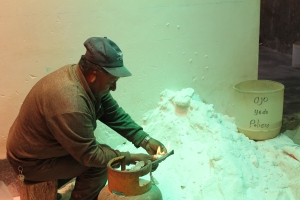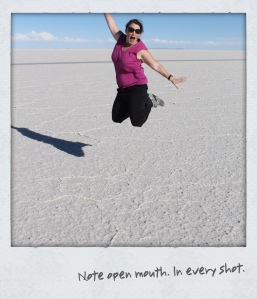Here is what I learn from the Salar: grown ups need to climb stuff more. It starts six minutes out of town, when we go to the Train Cemetery. It is swarmed with people from other tour jeeps. The light isn’t great for photos, so I’m glad I was here 16 hours ago on my own. Instantly, people of otherwise respectable age are atop broken locomotives, walking their lengths, posing against the slick blue sky, and swinging from a swing shaped like two dog bones suspended from the ribs of an old train car. It doesn’t stop there, and most of the time, I’m happily in the mix.
The salt flats are amazing, as you can see from the pictures. Walking on the salt field is like walking on slushy snow, only more compact, and not slippery. So basically, nothing like slushy snow, except for its appearance.
The air is hot and whipping with wind, and all you can see is a vast, flat, field of white, bordered in the distance by hills rising from nowhere. There is no road – only a ‘path’ of diesel dirt left by the million other tours around you, and followed by those who come behind.
After a photo shoot on the flats, we stop off in a town that harvests salt. Which means this is where the truck that is manually loaded is manually dumped, and then, manually, the salt is loaded onto a pan above a remedial wood-burning oven and sifted by shovel so that it dries out. It is then (manually, of course) mixed with iodine and bagged into small plastic sacks that are heat-sealed with a propane burner, and stacked for sale.
After the salt flats, our three-day, two-night tour goes to what is referred to as ‘la isla,’ so I assume we are taking a boat to an island in a lake somewhere. I’m forgetting, of course, that we are driving across what used to be the lake. ‘La isla’ is a cactus-covered red-rock out cropping in the middle of nowhere, rising from the salt flats with a completely independent vegetation zone.
You can climb on top of it, hike its perimeter, take pictures, and, if you are me, lead Travel Companion mistakenly off the proper trail so that by the time you eat lunch and leave, she has lost her iphone and will never find it again. If you are more touristy and have money to burn, you can pay the roving land-cruiser some extra bolivianos to go parasailing behind his car. I stick to climbing on things and leading others astray.
At the end of day one, we drive to the edge of the salt flats, stopping for more photo opportunities, in which our group learns that (1) it’s very hard to take a picture of two people simultaneously off the ground and (2) it’s physically impossible to get off the ground without opening your mouth.
We land for the night in a hostel with salt-brick walls and a floor made purely of salt, and since it is well insulated with…well, salt, and we’re terrified of freezing, we’re just fine with it all, even the spare hairs on the bed. Outside, the wind howls across the the landscape, brushing a herd of vicuna into the low hills and lulling us to sleep.
I have no idea what day two has in store, since we are on a salt tour, and I’ve been told we’re at the end of the salt. I do know that somewhere in the next 48 hours, I’m going to get to see some flamingos, which I keep calling penguins. By the time they’ve known me for 24 hours, though, my tour team is unphased by my behavior. They know that when I say penguin, I mean flamingo.
Day two starts with rocks, and moves on to volcanoes, with a train track or two thrown in for good measure. Just to be safe, I climb on everything I possibly can, including in and out of the third row of the car, which Travel Companion has advised me to stop doing in one stretch at the risk of pulling a groin muscle. I do not climb the volcano, which is disappointingly far in the distance.
I am not alone in climbing. I am alone when I lie down on the train track to have my picture taken like a damsel in distress, minus the distress and the damsel-ness. Minus also an oncoming train and a wily cowboy to rescue me. I will blame this on sugar snacks before ten a.m. (I have a much better understanding of Cookie Crisp cereal after my Salar tour.)
At this point, it has become abundantly clear that any fear we have of our driver irresponsibly abandoning us in the middle of nowhere carries no muster. At almost every stop, Garcia wanders off to help another driver with a bad tire, leaky oil, or a jeep that plain won’t start. Aside from him being a skilled mechanic, we will never be alone. At every stop, there are at least four, and usually six to ten, other groups stopping to take the same pictures, and climb on the same rocks. Lack of solitude in the middle of nowhere makes for very indiscrete natural bathroom opportunities, which Travel Companion and I discover the hard way.
From salt and rocks we move on to a series of Lagunas. I forget the order of them but most are named after colors (Laguna Verde, Laguna Blanca – this one was the very last, Laguna Colorado). Many appear to have great salt crusting on their banks, but this turns out to be borax. Each of them is home to some naturally occurring mineral that changes the color of the water. In the case of Laguna Colorado, sun and heat during the day bloom a red algae that, just for a few hours, turns great parts of the lake red.
All of the lagunas save one have flamingos, and my camera finger goes into autopilot, shooting everything in sight, knowing that maybe five of these will ultimately be worth the time. Bless digital photography: for all its weaknesses and the people it’s put out of work, it sure makes being an amateur a lot less expensive.
We eat lunch next to a large, full lake of pink and white birds, and are accompanied by some Andean gulls, which are seagulls with black heads. There is a little café and hotel with a sign advertising wifi, so the lone Brazilian gets very excited, and then is dismayed to learn that, ‘it is only turned on at night.’ The rest of us doubt there are even lights here at night, and the smell of the chemical toilet is so overwhelming you can’t breathe and pee at the same time, so I’m pretty sure that wifi thing is a ruse.
The Brazilian couple cuts up pieces of food and throws them into the air near the table so that the Andean gulls will fly up and form the perfect picture, and the rest of us find this highly amusing. It is so windy that we have dirt as a spice on our food (which isn’t hot dogs, but could use a little spice), but it is not cold. Garcia moves the car to try and make a wind block, but the effort is futile.
A couple arrives on bikes. Reiteration: there are no actual roads. We have been driving through salt and sand for more than a day. Partly because yes, it’s fun, but mostly because THERE ARE NO ROADS. They are not the first cyclists we’ve seen, but these have a sign on the back of one bike that says, “luna de miel,” – honeymoon – at which point I add this particular gentleman to the very long list of people I’ve decided I can never marry. I go stick my nose in their business and discover they’ve biked from Mexico and are headed to Patagonia.
We are astounded by these two and comment on them off and on for the next two hours until we stop at an unnamed rock outcropping (we haven’t climbed anything since this morning, and the natives are getting restless), where we meet a Swiss couple with two of the dirtiest children I’ve ever seen, one of whom is still wearing diapers, that have been cycling for three months and are also headed very far south.
If you haven’t read Part II of this adventure, you may have missed the part where Travel Companion and I take a cab five blocks mostly because of the weight of water. If you are skimming, you may have missed multiple references to the constant velocity of wind, and the sand that is providing texture for everything from our hair to our food. I am in awe of the adventure this family is on. I forgive them for letting their five year old run around with a pacifier in her mouth. When she starts climbing up the rock face with us, both Travel Companion and I are unsure whether to encourage her or tell her parents. When she gets about six feet above ground, her father comes over and coaxes her down. Awe.
Tonight, we sleep together, our little jeep family in a large hostel room, each in his or her own bed with 14 layers of clothing. The howling wind comes in through the cracks near the window frame and threatens to lift the roof off the hostel. We are waking at 5 a.m. to see some geysers at sunrise, so we go to bed at 8:30.
The geysers are worth the wake-up call (which all of us heed except Garcia, who is nowhere to be found). The sun is up, but barely, gleaming on the horizon and powering through sulpheric steam…
while great hordes of tourists roam dangerously close to craters of bubbling mud that gurgle, then blast into the air.
There is a sign that says not to get too close, but nothing to prevent you from doing so. We ask Garcia when people have last fallen in. It was three years ago, and the man suffered severe burns on much of his body.
The tour could end here. We are happy, cold, and done with the car. But there are more lakes to see, and despite having told us basically nothing about any of our locations except what they are called, Garcia would not feel he were doing his job if we were to bypass anything. So we head to the first lake we’ve seen with absolutely no flamingos. Why? Well, because the naturally occurring mineral here is arsenic.
I rename this one Arsenic Lake. It may actually be Asbestos Lake but it is lacking penguins and honestly not the best one we’ve seen so, whatever. The last is Laguna Blanca, which has such a smooth surface that it reflects the mountains of Bolivia like a mirror at the beginning of the day.
And then, we are done. Thirty minutes later, we are at the border. Travel Companion, Irish and I offload and go to the migration hut for exit stamps and then await the bus for San Pedro, where we hope Chile will bring a little less dirt and a lot less hair. The Brazilians change jeeps for a full-day drive back to Uyuni. Garcia drives off to upload another group of six and do the whole thing over again, and again.





















Wow. Great photos and great post!